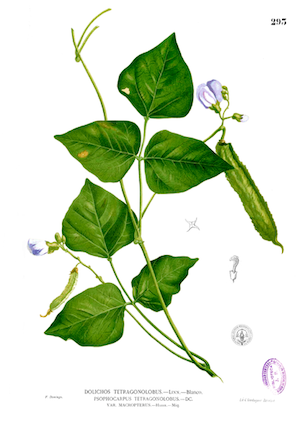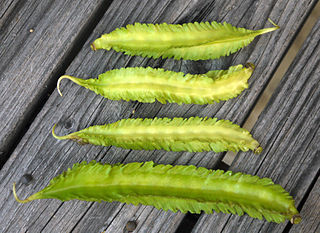Interesting Plant: Asparagus Pea (Psophocarpus tetragonolobus)

Click for larger images
Interesting Plant: Asparagus Pea (Psophocarpus tetragonolobus)
“The Winged bean (Psophocarpus tetragonolobus), also known as the Goa bean and Asparagus pea, Four-angled bean and Winged pea, is a tropical legume plant native to New Guinea. It grows abundantly in hot, humid equatorial countries, from the Philippines and Indonesia to India, Burma, Thailand and Sri Lanka. It does well in humid tropics with high rainfall. There are also varieties that can be grown in most areas of the U.S..
The winged bean plant grows as a vine with climbing stems and leaves, 3–4 m in height. It is an herbaceous perennial, but can be grown as an annual. It is generally taller and notably larger than the Common bean. The bean pod is typically 15–22 cm (6–9 in) long and has four wings with frilly edges running lengthwise. The skin is waxy and the flesh partially translucent in the young pods. When the pod is fully ripe, it turns an ash-brown color and splits open to release the seeds. The large flower is a pale blue. The beans themselves are similar to soybeans in both use and nutritional content (being 29.8% to 39% protein).” — Wikipedia.org
I had never heard of the Asparagus Pea until last Saturday night during the Wisconsin Vegetable Garden Google Hangout. Carol and Kerrie from the Seed Keeper Company mentioned that this was one of the new plants they were growing this year. After my reading about the plant, it seems an amazing thing to grow. I might have to check it out myself, even with my well-known aversion to peas in general. Perhaps this is different enough to find a way into my diet.
More information on Asparagus Pea (Psophocarpus tetragonolobus):
- Asparagus Pea (Psophocarpus tetragonolobus) on Wikipedia
- The Asparagus Pea—A Wonderfully Frolicsome Legume from the Brooklyn Botanic Garden
- Asparagus Pea at Going to Seed
Previously in the Interesting Plant series:
- Rosa banksiae (Lady Banks’ Rose)
- Primula ‘Victoriana Silver Laced Black’
- Oxalis versicolor
- Poached Egg Plant (Limnanthes douglasii)
- Parisian Carrots
- Fritillaria imperialis Rubra Maxima
- Clematis “Fascination”
- Swiss Chard “Bright Lights”
- Georgia Rattlesnake Melon
- Dianthus Barbathus “Green Ball” or “Green Trick”
- Coleus “Religious Radish”
- Black Forest Calla Lily
- Black Bamboo

